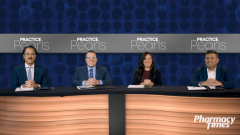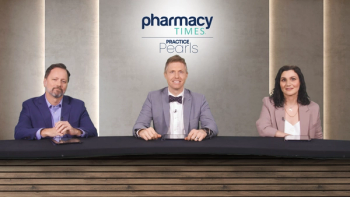
Ensuring Adherence to Hemophilia A Therapies
Experts discuss best practices for improving patient adherence to hemophilia A therapies, including addressing adherence issues and patient engagement.
Episodes in this series

Jonathan Ogurchak, PharmD, CSP: Now, adherence to these therapies is always critical, and especially with those patients who are on prophylactic type of dosing. Dr Schrade, what are some best practices that you’ve seen for helping to ensure that patients are adherent to therapy so you’re not running into a lot of those acute-need types of issues?
Lisa Schrade, PharmD: Our conversations usually evolve on a monthly basis with our patients to follow their care. First and foremost we have the conversation to find out why there are adherence issues. It might be economic, it might be time constraints, there might be disruptions in the family that we’re not aware of. We try to engage in conversation with the patients so that we can kind of build that rapport with them, so they know that they’re individuals and we’re just not tailoring for their drugs because we’re trying to fill their prescription. We find out what the adherence problems are first and then we try to move forward from that point. If it’s a matter of them not being able to remember or they just get really busy during the day, we do encourage them if they have a smartphone device to add a calendar reminder that goes off on a regular basis. There’s utilization of applications that encourage them to adhere to their program. Our pharmacy for prophylaxis patients as well, or they’re infusing or injecting on a regular monthly basis. We do courtesy calls, try to catch them about every 3 weeks to start initiating that conversation, like, “Hey, we know that you’re going to be running low pretty soon; do you want to go ahead and refill your product?” I do have some patients that just their adherence is horrible; they’re on prophylaxis therapy and they’re just not going to adhere to it no matter what. We have a conversation with the provider and say, “Hey, what’s the best practice here? Do we maintain them on this product or do we just offer them on-demand therapy?” There’s a lot of conversations that happen primarily with the patient, and from that takeaway we engage with the provider and make sure that we’re making the best choices for the patient because again, if they’re not going to adhere, then we have to find another avenue so that they’re treating their bleeds effectively.
Jonathan Ogurchak, PharmD, CSP: That makes perfect sense.
Robert Sidonio Jr, MD, MSc: The specialty pharmacy is really critical here, because I write the prescription, I’ve seen the patient and then I go about my business. I don’t know if they’re [taking] it home, and most people aren’t going to admit in clinic that they’re not doing what you’re supposed to do. Most of us wouldn’t admit that as well. We have multiple special pharmacies in our area. We try to communicate with them on a regular basis and they’ll inform us and say, “Hey, Johnny hasn’t been ordering it like he’s supposed to.” There’s no way that he’s actually adherent. We’ll try to confront the family and see because...there could be something going on, some family issues or something.... Pharmacy will send people out to the house and they’ll communicate by phone because a lot of those sort of life issues get in the way of adherence. The good thing about emicizumab is it’s a little more forgiving. The half-life is about 28 days. Missing a dose slightly or a couple of days isn’t going to really affect hemostasis in any way. The problem is when you miss factor products, you miss it by a day, that’s a significant problem. You miss a few doses here and there, it puts you at risk and you’re spending more time in the lower range than you would like them to. That’s where it becomes difficult. There are just some patients, like Dr Schrade mentioned, who just aren’t adherents. We just try our best and try to come up with strategies. Sometimes we just have to compromise and say, “This isn’t the ideal regimen, but this is what they’re willing to do.” You just make these compromises. Usually this starts in the teenage boy years and you’re having to be compromised because you want them to get something or you have to alter your regimen to make sure that they’re protected. You write this and then you hope that they at least get 75% of it, they’ll be okay. That’s sort of this typical life scenario. You’re just trying to do the best and trying to make sure your patients are protected.
Atta Chowdhry, RPh: That’s like as a younger person, and any younger person with a chronic disease, it is a stage you hit where you think you are invincible and you don’t need any of all that stuff. That’s the hard part in the lifestyle, to remind them that it can affect the joints that can cause a lot of other problems down the road, and so it’s better to pay attention and stick to the red.
Robert Sidonio Jr, MD, MSc: It’s really hard if you’re 14 years old and say, “Well, the decisions you make now will affect you in your 20s and 30s; you won’t notice anything now, but you’ll notice it, when you’re going to wake up in the morning and [have] stiffness, you’re going to have a limp.” These are things they don’t—it’s hard for a teenager to think even about the next day; they’re not going to project 10, 20 years from now.
Lisa Schrade, PharmD: That’s why it’s important too to have that conversation to find out what their lifestyle is like outside of just their medication regimen. For instance, you have your 14-year-old boy who’s very active in soccer and say “Hey, I know you’ve got a big game coming up this Saturday, do you want to make that game? Then you need to make sure that you would stay adherent, otherwise you’re going to miss these games, you’re going to miss a lot more games if you can get down this pathway.” Even for our older individuals, like in their 30s and 40s, they’re just like, “Oh well, I forgot.” You try to have the conversation with them about the long-term health consequences. You know, the hemiarthroplasties that they’re going to experience, their quality of life is not going to be to the same level that they are experiencing right now. Do you plan on having children yourself, do you want to go outside and play with your kids? Because right now you’re trying to limit what you’re able to do in the future if you’re not able to be adherent to your therapy.
Robert Sidonio Jr, MD, MSc: We always talk about like [with] the teenage boys, I say, “Do you ever go to meetings and you see guys walking around?” I say I can usually pick out who has hemophilia if they’re in their 40s or 50s because they’re going to have some kind of gait problem or a limp or something and they’re going to have shoe lifts, all these things, you could tell who’s had surgeries. I said that’s what it used to be like, those guys didn’t start prophylaxis at a young age and so they’ve kind of accepted this sort of fate. But you don’t have to accept that. We have good products that you can’t eliminate hemiarthroplasty, but you certainly can delay it until much later in life and at some point hopefully we could completely eliminate it, but we’re not quite there yet.
Atta Chowdhry, RPh: One thing I just want to add to it, while they’re at home, the parents can drive them to get that product, but once they go to college, or they’re outside the house, that’s the hard part of it.
Robert Sidonio Jr, MD, MSc: Mom’s not around.
Atta Chowdhry, RPh: Because then they are not responding to your text or your calls, and that’s the hard part. Those are the conversations to ask them to, hey, take the time out, and figure out that you have a chronic disease, and it needs to be what you call maintained, or taken care of, so you can treat it like a valve to maintain condition instead of causing some long-term damage to it.
Jonathan Ogurchak, PharmD, CSP: Yeah, unfortunately, that move away to college sense...where that invincibility really kicks off with all the independence, though.
Transcript is AI generated and reviewed by a Pharmacy Times editor.
Newsletter
Stay informed on drug updates, treatment guidelines, and pharmacy practice trends—subscribe to Pharmacy Times for weekly clinical insights.






































































































































































































